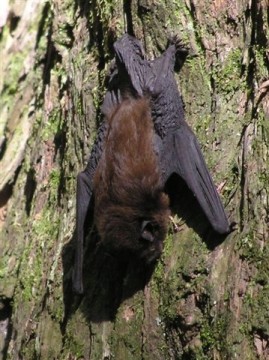Bat rescue
Blogger: Top of the South Field Officer, Debs Martin
At dusk on a warm November evening in 2005, I was crawling into my tent for a bite of dark rich warming chocolate and spotted the erratic flight path of what looked like a swallow above the giant kahikatea trees encircling the Pelorus campground.
The ‘bird’s’ crazy darting flight had me perplexed for a while, until it dawned on me that I had clapped eyes on New Zealand’s only land mammal: a bat!
A bat-encounter is a rare thing in New Zealand– they are not only enigmatic and nocturnal, they’re becoming increasingly rare.
Once widespread, our two species of bats are now eking out their existence in dwindling scraps of forests throughout New Zealand – favouring river valleys and remaining red beech forests.
Surprisingly, we don’t know enough about bats and the extent of their populations, and their secretive nature doesn’t assist us in helping to save them.
Regional surveys in the top of the South Island show that once more widely spread, their presence is dwindling to pocket enclaves.
This decline has been marked since the 1960s – although without comprehensive research and knowledge, we cannot readily assign a cause. It may be a combination of factors.
Last year, the Department of Conservation upgraded our South Island long-tailed bat threat status to nationally critical. The next stop is extinction.
The population at Pelorus River Scenic Reserve is one of the long-tailed bat strongholds in the top of the South Island and it population is estimated to sit at just 20 -30 bats.
In an effort to protect these creatures we’ve initiated a Bat Protection Project with the help of volunteers, DOC, Ngati Kuia, and our on-the-ground bat expert, Dr Brian Lloyd.
The project is taking a two-pronged approach to bolster this bat population: pest control combined with population & food-source research.
Aside from predation, Brian believes the long-tailed and short-tailed bat’s demise may be due to competition from introduced German and Common wasps.
In late summer these wasps form large swarms in our beech forest lapping up every last drop of nectar and decimating the insect population – in effect leaving little food for our bats.
He believes the reason for the remaining population at Pelorus Bridge and campground is because they live in ancient podocarp forest with nearby streetlights supplying a regular source of food.
Podocarp forest is not the favoured feeding ground for wasps because it doesn’t contain honey-dew beech. http://www.teara.govt.nz/en/southern-beech-forest/3/5
A future we want to avoid is telling our grandchildren the sad tale of the last of the long-tailed bats in the South Island.
And although we are rightly proud of the work we are doing at Pelorus Bridge, pocket enclaves aren’t enough to ensure the future of a species that can range widely over catchments. Not only do we need the intensive effort of our project at Pelorus Bridge, but the combined efforts of ongoing and increased research and support by science, and adequate funding to the DOC so they can continue pest control on a landscape scale.
And next November I’ll tip my hat to the bat that launched it all.

